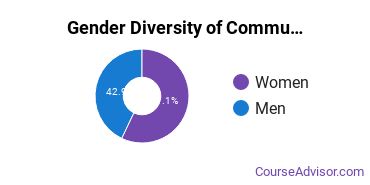Communication & Journalism at California State University - Sacramento
Sac State is located in Sacramento, California and has a total student population of 32,293.
Want to know more about the career opportunities in this field? Check out the Careers in Communication & Journalism section at the bottom of this page.
Sac State Communication & Journalism Degrees Available
- Bachelor’s Degree in Communication & Journalism
- Master’s Degree in Communication & Journalism
Sac State Communication & Journalism Rankings
The communication & journalism major at Sac State is not ranked on College Factual’s Best Colleges and Universities for Communication & Journalism. This could be for a number of reasons, such as not having enough data on the major or school to make an accurate assessment of its quality.
Find California State University - Sacramento Programs
With an online bachelor's degree in communication you'll have the opportunity to pursue a multitude of career options. From journalism and social media, to public relations, advertising and mass media, earning your BA in communication will allow you to strategize and communicate your ideas.
Effective communicators are always in demand, no matter the industry. The Master's in Communication degree from Southern New Hampshire University is a cutting-edge program designed for forward-thinking professionals.
BA in Communication - New Media
Explore the digital frontier as it relates to today's communications strategies with this specialized online bachelor's from Southern New Hampshire University.
Communication & Journalism Student Demographics at Sac State
Take a look at the following statistics related to the make-up of the communication & journalism majors at California State University - Sacramento.
Sac State Communication & Journalism Bachelor’s Program

Prospective students may be interested in knowing that this school graduates 30% more racial-ethnic minorities in its communication & journalism bachelor's program than the national average.*
The following table and chart show the race/ethnicity for students who recently graduated from California State University - Sacramento with a bachelor's in communication & journalism.

| Race/Ethnicity | Number of Students |
|---|---|
| Asian | 50 |
| Black or African American | 46 |
| Hispanic or Latino | 159 |
| White | 116 |
| International Students | 3 |
| Other Races/Ethnicities | 60 |
Sac State Communication & Journalism Master’s Program

In the communication & journalism master's program at this school, racial-ethnic minorities make up 50% of degree recipients. That is 12% better than the national average.*
The following table and chart show the race/ethnicity for students who recently graduated from California State University - Sacramento with a master's in communication & journalism.

| Race/Ethnicity | Number of Students |
|---|---|
| Asian | 0 |
| Black or African American | 1 |
| Hispanic or Latino | 4 |
| White | 3 |
| International Students | 0 |
| Other Races/Ethnicities | 2 |
Concentrations Within Communication & Journalism
Communication & Journalism majors may want to concentrate their studies in one of these areas. The table shows all degrees awarded in this field awarded for all degree levels at California State University - Sacramento. A concentration may not be available for your level.
| Concentration | Annual Degrees Awarded |
|---|---|
| Communication & Media Studies | 492 |
| Journalism | 41 |
Related Majors
- Philosophy & Religious Studies
- Foreign Languages & Linguistics
- Family, Consumer & Human Sciences
- Area, Ethnic, Culture, & Gender Studies
- History
Related Programs
Learn about other programs related to California State University - Sacramento that might interest you.
BA in Communication - New Media
Explore the digital frontier as it relates to today's communications strategies with this specialized online bachelor's from Southern New Hampshire University.
BA in Communication - Public Relations
Prepare to develop your skills in building mutually beneficial relationships between organizations and their public audiences.
MA in Communication - New Media & Marketing
Keep your skills and knowledge at the forefront of new media technologies with this specialized online master's from Southern New Hampshire University.
Careers That Communication & Journalism Grads May Go Into
A degree in communication & journalism can lead to the following careers. Since job numbers and average salaries can vary by geographic location, we have only included the numbers for CA, the home state for California State University - Sacramento.
| Occupation | Jobs in CA | Average Salary in CA |
|---|---|---|
| Managers | 66,300 | $143,350 |
| Public Relations Specialists | 26,820 | $72,910 |
| Producers and Directors | 25,320 | $115,080 |
| Film and Video Editors | 11,380 | $112,530 |
| Editors | 11,060 | $78,150 |
References
*The racial-ethnic minorities count is calculated by taking the total number of students and subtracting white students, international students, and students whose race/ethnicity was unknown. This number is then divided by the total number of students at the school to obtain the racial-ethnic minorities percentage.
- College Factual
- National Center for Education Statistics
- O*NET Online
- Image Credit: By Stickpen under License
More about our data sources and methodologies.

